四种基本时态
- 格式:pptx
- 大小:13.99 MB
- 文档页数:22
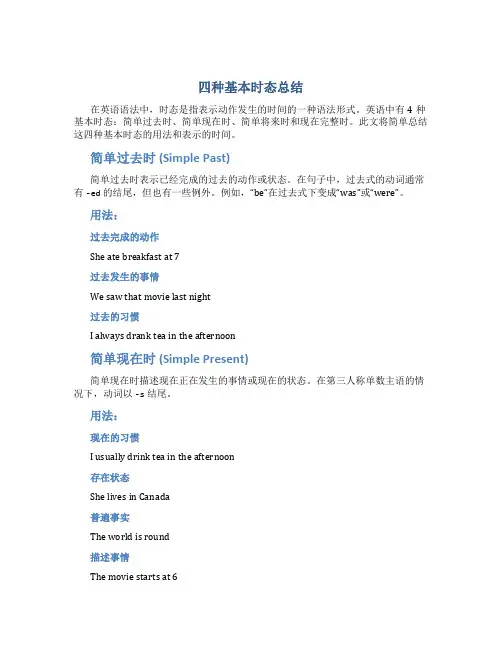
四种基本时态总结在英语语法中,时态是指表示动作发生的时间的一种语法形式。
英语中有4种基本时态:简单过去时、简单现在时、简单将来时和现在完整时。
此文将简单总结这四种基本时态的用法和表示的时间。
简单过去时 (Simple Past)简单过去时表示已经完成的过去的动作或状态。
在句子中,过去式的动词通常有-ed的结尾,但也有一些例外。
例如,“be”在过去式下变成“was”或“were”。
用法:过去完成的动作She ate breakfast at 7过去发生的事情We saw that movie last night过去的习惯I always drank tea in the afternoon简单现在时 (Simple Present)简单现在时描述现在正在发生的事情或现在的状态。
在第三人称单数主语的情况下,动词以-s结尾。
用法:现在的习惯I usually drink tea in the afternoon存在状态She lives in Canada普遍事实The world is round描述事情The movie starts at 6简单将来时 (Simple Future)简单将来时用于表示将来某个时间会发生的事情。
可以使用情态助动词will 和shall加上动词原形,也可以使用动词原形来表示未来。
用法:趋势I think gasoline prices will go up.决定或意愿I’ll help you with that homework after dinner在特定的时间或时间段内发生I’ll finish my homework by 9 PM现在完成时 (Present Perfect)现在完成时通常用于强调过去发生的事情与现在的联系。
它与简单过去时明显不同,因为它包括从过去开始,延续到现在或在过去一点时间内的动作或状态。
在句子中,现在完成时通常使用have或has和动词的过去分词。
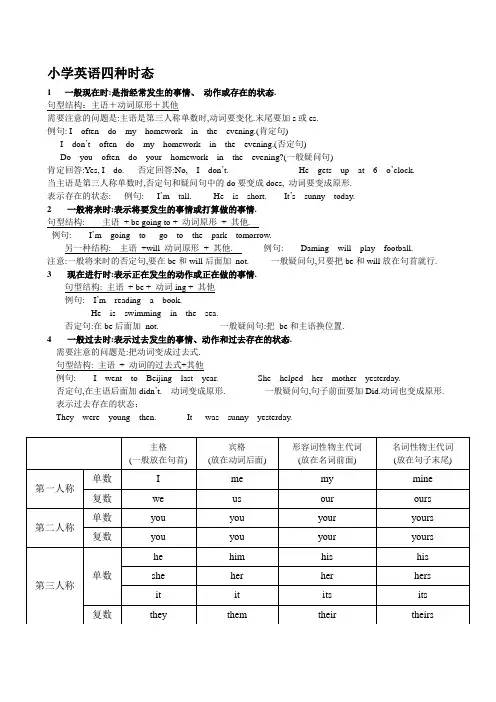
小学英语四种时态1一般现在时:是指经常发生的事情、动作或存在的状态.句型结构:主语+动词原形+其他需要注意的问题是:主语是第三人称单数时,动词要变化.末尾要加s或es.例句: I often do my homework in the evening.(肯定句)I don’t often do my homework in the evening.(否定句)Do you often do your homework in the evening?(一般疑问句)肯定回答:Yes, I do. 否定回答:No, I don’t. He gets up at 6 o’clock.当主语是第三人称单数时,否定句和疑问句中的do要变成does, 动词要变成原形.表示存在的状态: 例句: I’m tall. He is short. It’s sunny today.2一般将来时:表示将要发生的事情或打算做的事情.句型结构: 主语+ be going to + 动词原形+ 其他.例句: I’m going to go to the park tomorrow.另一种结构: 主语+will 动词原形+ 其他. 例句: Daming will play football.注意:一般将来时的否定句,要在be和will后面加not. 一般疑问句,只要把be和will放在句首就行. 3现在进行时:表示正在发生的动作或正在做的事情.句型结构: 主语+ be + 动词ing + 其他例句: I’m reading a book.He is swimming in the sea.否定句:在be后面加not. 一般疑问句:把be和主语换位置.4一般过去时:表示过去发生的事情、动作和过去存在的状态.需要注意的问题是:把动词变成过去式.句型结构: 主语+ 动词的过去式+其他例句: I went to Beijing last year. She helped her mother yesterday.否定句,在主语后面加didn’t. 动词变成原形. 一般疑问句,句子前面要加Did.动词也变成原形.表示过去存在的状态:They were young then. It was sunny yesterday.。
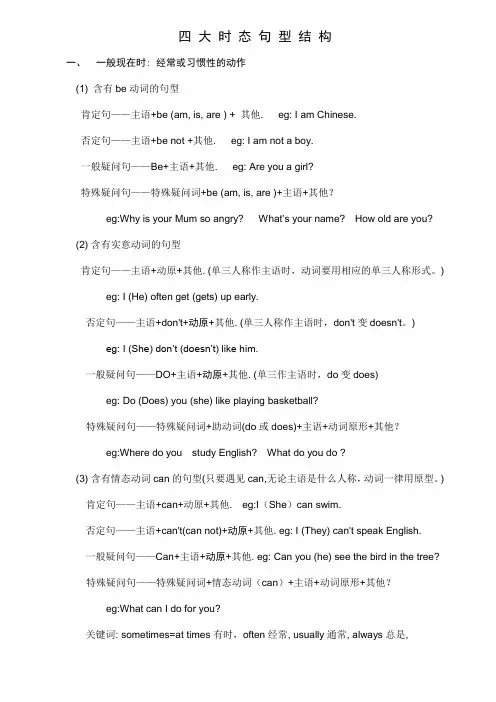
四大时态句型结构一、一般现在时: 经常或习惯性的动作(1) 含有be动词的句型肯定句——主语+be (am, is, are ) + 其他. eg: I am Chinese.否定句——主语+be not +其他. eg: I am not a boy.一般疑问句——Be+主语+其他. eg: Are you a girl?特殊疑问句——特殊疑问词+be (am, is, are )+主语+其他?eg:Why is your Mum so angry? What’s your name? How old are you? (2) 含有实意动词的句型肯定句——主语+动原+其他. (单三人称作主语时,动词要用相应的单三人称形式。
) eg: I (He) often get (gets) up early.否定句——主语+don't+动原+其他. (单三人称作主语时,don't变doesn't。
) eg: I (She) don’t (doesn’t) like him.一般疑问句——DO+主语+动原+其他. (单三作主语时,do变does)eg: Do (Does) you (she) like playing basketball?特殊疑问句——特殊疑问词+助动词(do或does)+主语+动词原形+其他?eg:Where do you study English? What do you do ?(3) 含有情态动词can的句型(只要遇见can,无论主语是什么人称,动词一律用原型。
)肯定句——主语+can+动原+其他. eg:I(She)can swim.否定句——主语+can't(can not)+动原+其他. eg: I (They) can't speak English.一般疑问句——Can+主语+动原+其他. eg: Can you (he) see the bird in the tree?特殊疑问句——特殊疑问词+情态动词(can)+主语+动词原形+其他?eg:What can I do for you?关键词: sometimes=at times有时,often经常, usually通常, always总是,every day每天, on Sunday afternoon在周日下午, five days a week一周五天, three times a month一个月三次…二、现在进行时: 正在发生的动作或存在的状态肯定句——主语+be+动词的现在分词(ing)+其他. eg: I am reading now.否定句——主语+be not+动词的现在分词(ing)+其他. eg: I am not working.一般疑问句——Be +主语+动词的现在分词(ing)+其他? eg: Are you sleeping?特殊疑问句——特殊疑问词+ be +主语+动词的现在分词(ing)+其他?eg:What are you doing?关键词:now现在, at the moment此刻, look, listen, keep quiet等提示语.三、一般将来时: 将要发生的动作(1)含有will的句型肯定句——主语+will+动词原型+其他. eg: I will call you later.否定句——主语+will not +动词原型+其他. eg: I will not go to the park.一般疑问句——Will +主语+动词原型+其他. Will you go shopping with her?特殊疑问句——特殊疑问词+will +主语+动词原形+其它?(will 可改为be going to ,疑问句中当主语是第一人称时will改为shall)(2)含有be going to 的句型肯定句——主语+be(am / is / are) + going to +动词原形+其它.否定句——主语+be(am / is / are)+not + going to +动词原形+其它.一般疑问句——Be(am / is / are) +主语+ going to +动词原形+其它?特殊疑问句——特殊疑问词+ be(am / is / are) +主语+ going to +动词原形+其它?关键词:tomorrow, next year明年, tonight今晚, this year今年, at the end of this term这学期期末, from now on从现在开始, soon一会儿马上, later后稍后,in three days三天之内, in the future未来…四、一般过去时: 过去发生的动作强调时间(1)含有be动词的句型肯定句——主语+be(was,were)+其他. eg: I was born on July.1st, 2000.否定句——主语+be(was,were) not+其他. eg: I was not born in 1999.一般疑问句—Be(was,were)+主语+其他? eg: Were you born in January?特殊疑问句—特殊疑问词+ be(was,were)+主语+其他. eg: When was he born?(2)含有实意动词过去式的句型肯定句——主语+动词的过去式+其他. eg: Lily went shopping yesterday.否定句——主语+did not+动原+其他. eg: He did not go to school today.一般疑问句——Did+主语+动原+其他? eg:Did she pass the test?特殊疑问句—特殊疑问词+did+主语+动原+其他. eg:Where did you go yesterday?关键词:yesterday昨天,last week上周, last year去年, 一段时间+ago如ten years ago十年前five hours ago五小时前, in +年/月,on+具体日期...Just now=a moment ago刚才,in the old days从前, long ago很久以前...。
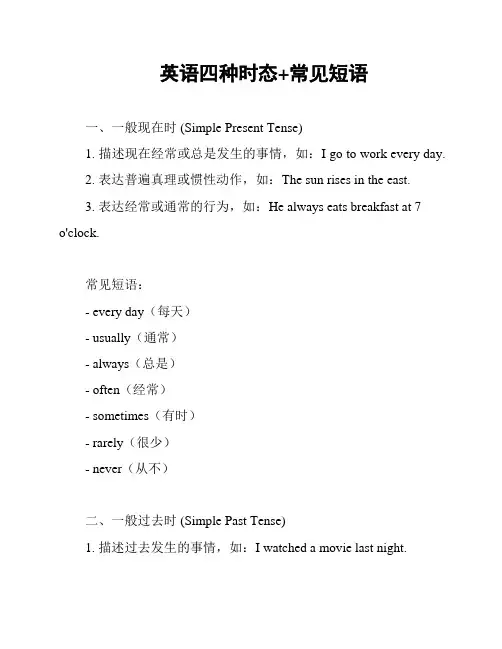
英语四种时态+常见短语一、一般现在时 (Simple Present Tense)1. 描述现在经常或总是发生的事情,如:I go to work every day.2. 表达普遍真理或惯性动作,如:The sun rises in the east.3. 表达经常或通常的行为,如:He always eats breakfast at 7o'clock.常见短语:- every day(每天)- usually(通常)- always(总是)- often(经常)- sometimes(有时)- rarely(很少)- never(从不)二、一般过去时 (Simple Past Tense)1. 描述过去发生的事情,如:I watched a movie last night.2. 表达过去常常发生的动作,如:He often went fishing when he was young.3. 表达过去的惯,如:We lived in that house for many years.常见短语:- yesterday(昨天)- last night(昨晚)- a week ago(一周前)- in the past(在过去)- when I was young(在我年轻的时候)- for many years(多年来)- in those days(在那些日子里)三、一般将来时 (Simple Future Tense)1. 表达将来会发生的事情,如:I will visit my grandparents next week.2. 表示打算或计划做的事情,如:We are going to have a party on Saturday.3. 表达预测的事件,如:I think he will win the game.常见短语:- next week(下周)- in the future(在未来)- tomorrow(明天)- on Saturday(在星期六)- be going to(打算)- will(将)- I think(我认为)四、现在进行时 (Present Continuous Tense)1. 描述现在正在发生的事情,如:She is studying in the library right now.2. 表达将来安排好的事情,如:We are leaving for a vacation next month.3. 表示暂时的情况,如:He is living with his sister while his house is being renovated.常见短语:- right now(现在)- at the moment(此刻)- in the near future(不久的将来)- next month(下个月)- while(在...期间)- currently(目前)- at present(现在)以上是英语中四种常见的时态以及常见的短语,掌握这些时态和短语可以帮助你更准确地表达过去、现在和将来的事件和状态。
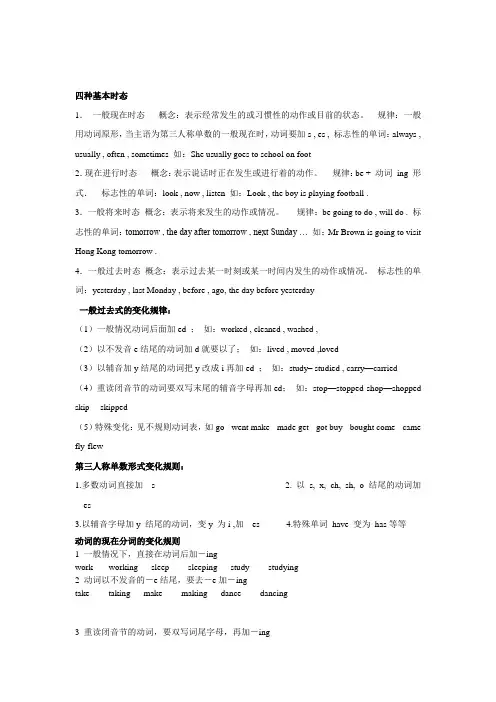
四种基本时态1.一般现在时态概念:表示经常发生的或习惯性的动作或目前的状态。
规律:一般用动词原形,当主语为第三人称单数的一般现在时,动词要加s , es , 标志性的单词:always , usually , often , sometimes 如:She usually goes to school on foot2.现在进行时态概念:表示说话时正在发生或进行着的动作。
规律:be + 动词ing 形式.标志性的单词:look , now , listen 如:Look , the boy is playing football .3.一般将来时态概念:表示将来发生的动作或情况。
规律:be going to do , will do . 标志性的单词:tomorrow , the day after tomorrow , next Sunday … 如:Mr Brown is going to visit Hong Kong tomorrow .4.一般过去时态概念:表示过去某一时刻或某一时间内发生的动作或情况。
标志性的单词:yesterday , last Monday , before , ago, the day before yesterday一般过去式的变化规律:(1)一般情况动词后面加ed ;如:worked , cleaned , washed ,(2)以不发音e结尾的动词加d就要以了;如:lived , moved ,loved(3)以辅音加y结尾的动词把y改成i再加ed ;如:study– studied , carry—carried (4)重读闭音节的动词要双写末尾的辅音字母再加ed;如:stop—stopped shop—shopped skip--- skipped(5)特殊变化:见不规则动词表,如go - went make - made get - got buy - bought come - came fly-flew第三人称单数形式变化规则:1.多数动词直接加---s2. 以s, x, ch, sh, o 结尾的动词加---es3.以辅音字母加y 结尾的动词,变y 为i ,加---es4.特殊单词have 变为has等等动词的现在分词的变化规则1 一般情况下,直接在动词后加-ingwork ---- working sleep ----- sleeping study ----- studying2 动词以不发音的-e结尾,要去-e加-ingtake ----- taking make ----- making dance ----- dancing3 重读闭音节的动词,要双写词尾字母,再加-ingcut ----- cutting put ----- putting begin ------ beginning4 以-ie结尾的动词,把变成y再加-inglie ----- lying tie ----- tying die ----- dying可数名词的复数变化规则:1.一般情况加s :book-- books mouth---mouths house---houses girl---girls2.以s 、sh 、ch 、x结尾的加es :class--- classes box----boxes match----matches3.辅音字母+ y结尾的变y为i加es:city---cities country----countries party----parties factory----factories4.以o 结尾的词+es的只有以下词:heroes Negroes tomatoes potatoeszeroes/zeros以o 结尾并且词尾有两个元音字母+s :radios, zoos, bamboos ,(pianos ,kilos photos) 5.以f,fe 结尾的变f或fe为v +es : thief wife life knife wolf half leaf shelf。
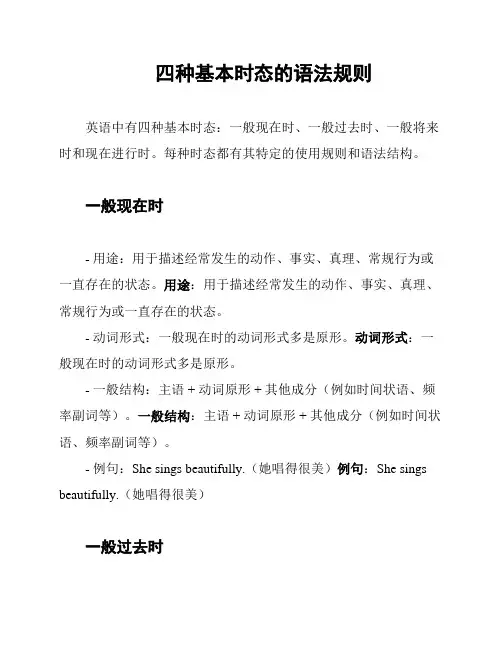
四种基本时态的语法规则英语中有四种基本时态:一般现在时、一般过去时、一般将来时和现在进行时。
每种时态都有其特定的使用规则和语法结构。
一般现在时- 用途:用于描述经常发生的动作、事实、真理、常规行为或一直存在的状态。
用途:用于描述经常发生的动作、事实、真理、常规行为或一直存在的状态。
- 动词形式:一般现在时的动词形式多是原形。
动词形式:一般现在时的动词形式多是原形。
- 一般结构:主语 + 动词原形 + 其他成分(例如时间状语、频率副词等)。
一般结构:主语 + 动词原形 + 其他成分(例如时间状语、频率副词等)。
- 例句:She sings beautifully.(她唱得很美)例句:She sings beautifully.(她唱得很美)一般过去时- 用途:用于描述已经发生的过去动作或状态。
用途:用于描述已经发生的过去动作或状态。
- 动词形式:一般过去时的动词形式通常以-ed或-d结尾,或者根据特定规则进行变化。
动词形式:一般过去时的动词形式通常以-ed或-d结尾,或者根据特定规则进行变化。
- 一般结构:主语 + 动词过去式 + 其他成分。
一般结构:主语+ 动词过去式 + 其他成分。
- 例句:He ate dinner at the restaurant last night.(昨晚他在餐厅吃了晚饭)例句:He ate dinner at the restaurant last night.(昨晚他在餐厅吃了晚饭)一般将来时- 用途:用于描述将来发生的动作或状态。
用途:用于描述将来发生的动作或状态。
- 动词形式:一般将来时的动词形式使用助动词will或be going to加上动词原形。
动词形式:一般将来时的动词形式使用助动词will或be going to加上动词原形。
- 一般结构:主语 + will/be going to + 动词原形 + 其他成分。
一般结构:主语 + will/be going to + 动词原形 + 其他成分。

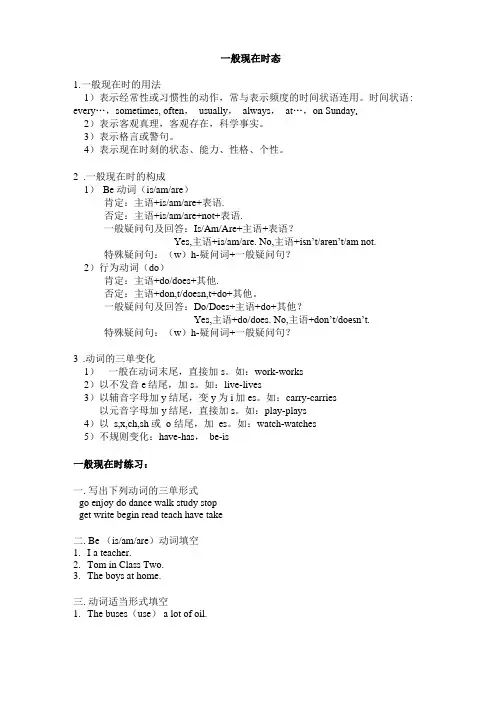
一般现在时态1.一般现在时的用法1)表示经常性或习惯性的动作,常与表示频度的时间状语连用。
时间状语: every…,sometimes, often,usually,always,at…,on Sunday o2)表示客观真理,客观存在,科学事实。
3)表示格言或警句。
4)表示现在时刻的状态、能力、性格、个性。
2.一般现在时的构成1)Be 动词(is/am/are)肯定:主语+is/am/are+表语.否定:主语+is/am/are+not+表语.一般疑问句及回答:Is/Am/Are+主语+表语?Yes,主语+is/am/are. No,主语+isn’t/aren’t/am not.特殊疑问句:(w)h-疑问词+一般疑问句?2)行为动词(do)肯定:主语+do/does+其他.否定:主语+don,t/doesn,t+do+其他。
一般疑问句及回答:Do/Does+主语+do+其他?Yes,主语+do/does. No,主语+don’t/doesn’t.特殊疑问句:(w)h-疑问词+一般疑问句?3.动词的三单变化1)一般在动词末尾,直接加s。
如:work-works2)以不发音e结尾,加s。
如:live-lives3)以辅音字母加y结尾,变y为i加es。
如:carry-carries以元音字母加y结尾,直接加s。
如:play-plays4)以s,x,ch,sh 或o 结尾,加es。
如:watch-watches5)不规则变化:have-has,be-is一般现在时练习:一.写出下列动词的三单形式go enjoy do dance walk study stopget write begin read teach have take二.Be (is/am/are)动词填空1.I a teacher.2.Tom in Class Two.3.The boys at home.三.动词适当形式填空1.The buses(use) a lot of oil.2.Each of us(have) strong points and weak points.3.My daughter(watch) TV every day. Sometimes she(see) a film on Sunday.4.Li Wei(have) a daughter. She(stay) in a nursery.(托儿所)5.Her mother(teach) English at a middle school.6.Jack often(listen) to the radio?7.They(play) football on Sundays.8.Daming often(go) to school on foot.9.We(not go) to school on Saturdays and Sundays.10.Tony(not have) piano lessons every day.四.句型转换1.They do morning exercises every day.否定句:一般疑问句:划线提问:2.Lucy does her homework in the evening.否定句:一般疑问句:划线提问:3.Her name is Li Mei.否定句:一般疑问句:划线提问:4.She has lunch at home every day.否定句:一般疑问句:划线提问:5.We have a meeting once a week.否定句:一般疑问句:划线提问:五.单项选择1.The Browns a nice car and Brown,s brother a nice jeepA. have/haveB. has/hasC. have/hasD. has/ have2.If their house not like ours, what it look like?A. is/isB. is/doesC. does/doesD. does/is3.--you think he will come? — If it tomorrow, he won,t come.A. Do/rainsB. Are/rainsC. Do/will rainD. Are/ will rain4.The little child not even know that the moon around the earth.A. do/moveB. do/movesC. does/movesD. did/moved一般过去时态1.一般过去时的用法1)表示在确定的过去时间里所发生的动作或存在的状态。
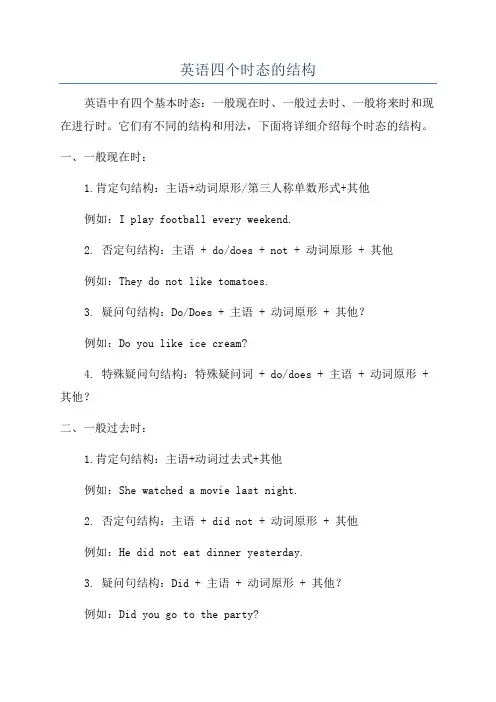
英语四个时态的结构英语中有四个基本时态:一般现在时、一般过去时、一般将来时和现在进行时。
它们有不同的结构和用法,下面将详细介绍每个时态的结构。
一、一般现在时:1.肯定句结构:主语+动词原形/第三人称单数形式+其他例如:I play football every weekend.2. 否定句结构:主语 + do/does + not + 动词原形 + 其他例如:They do not like tomatoes.3. 疑问句结构:Do/Does + 主语 + 动词原形 + 其他?例如:Do you like ice cream?4. 特殊疑问句结构:特殊疑问词 + do/does + 主语 + 动词原形 + 其他?二、一般过去时:1.肯定句结构:主语+动词过去式+其他例如:She watched a movie last night.2. 否定句结构:主语 + did not + 动词原形 + 其他例如:He did not eat dinner yesterday.3. 疑问句结构:Did + 主语 + 动词原形 + 其他?例如:Did you go to the party?4. 特殊疑问句结构:特殊疑问词 + did + 主语 + 动词原形 + 其他?例如:When did you arrive?三、一般将来时:1. 肯定句结构:主语 + will + 动词原形 + 其他例如:I will visit my grandma next week.2. 否定句结构:主语 + will not + 动词原形 + 其他3. 疑问句结构:Will + 主语 + 动词原形 + 其他?例如:Will you go to the concert?4. 特殊疑问句结构:特殊疑问词 + will + 主语 + 动词原形 + 其他?例如:Where will you travel next summer?四、现在进行时:1. 肯定句结构:主语 + am/is/are + 动词-ing + 其他例如:She is watching TV now.2. 否定句结构:主语 + am/is/are + not + 动词-ing + 其他例如:They are not studying for the exam.3. 疑问句结构:Am/Is/Are + 主语 + 动词-ing + 其他?例如:Are you playing basketball?4. 特殊疑问句结构:特殊疑问词 + am/is/are + 主语 + 动词-ing + 其他?例如:What are you doing tonight?以上就是英语四个基本时态的结构和用法。

千里之行,始于足下。
小学四种英语时态的归纳总结小学英语时态的归纳总结在小学阶段学习英语,掌握四种基本的时态是非常重要的。
这四种时态分别是一般现在时、一般过去时、一般将来时和现在进行时。
以下是对这四种时态的归纳总结。
一、一般现在时(Simple Present Tense)1. 表示经常性的动作或状态。
例如:I play basketball every Saturday.2. 在陈述句中,主语和动词要一致。
例如:He likes to watch movies.3. 在否定句中,用do / does + not + 动词原形。
例如:She does not like vegetables.4. 在疑问句中,用do / does + 主语 + 动词原形?例如:Do you have any pets?5. 用于表示客观事实、经验等。
二、一般过去时(Simple Past Tense)1. 表示过去发生的动作或状态。
例如:I watched a movie yesterday.2. 在陈述句中,动词过去式的变化规则是直接加-ed。
例如:We played soccer last week.3. 在否定句中,用did + not + 动词原形。
例如:She did not go to school yesterday.4. 在疑问句中,用did + 主语 + 动词原形?例如:Did you finishyour homework?第1页/共3页锲而不舍,金石可镂。
三、一般将来时(Simple Future Tense)1. 表示将来发生的动作或状态。
例如:I will go to the park tomorrow.2. 在陈述句中,用will / shall + 动词原形。
例如:She will visither grandparents next week.3. 在否定句中,用will not / won't + 动词原形。
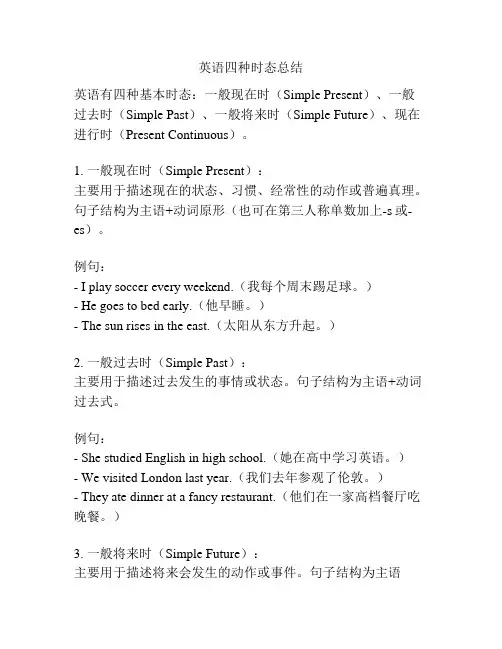
英语四种时态总结英语有四种基本时态:一般现在时(Simple Present)、一般过去时(Simple Past)、一般将来时(Simple Future)、现在进行时(Present Continuous)。
1. 一般现在时(Simple Present):主要用于描述现在的状态、习惯、经常性的动作或普遍真理。
句子结构为主语+动词原形(也可在第三人称单数加上-s或-es)。
例句:- I play soccer every weekend.(我每个周末踢足球。
)- He goes to bed early.(他早睡。
)- The sun rises in the east.(太阳从东方升起。
)2. 一般过去时(Simple Past):主要用于描述过去发生的事情或状态。
句子结构为主语+动词过去式。
例句:- She studied English in high school.(她在高中学习英语。
)- We visited London last year.(我们去年参观了伦敦。
)- They ate dinner at a fancy restaurant.(他们在一家高档餐厅吃晚餐。
)3. 一般将来时(Simple Future):主要用于描述将来会发生的动作或事件。
句子结构为主语+will+动词原形。
例句:- I will go to the gym tomorrow.(我明天会去健身房。
)- She will take the exam next week.(她下周会参加考试。
)- We will have a party on Friday.(我们星期五会举办一场派对。
)4. 现在进行时(Present Continuous):主要用于描述当前正在进行的动作。
句子结构为主语+be动词(am/is/are)+动词的ing形式。
例句:- They are watching a movie now.(他们正在看电影。
小学英语基础时态4种一、一般现在时一般现在时基本用法介绍【No. 1】一般现在时的功能1.表示事物或人物的特征、状态。
如:The sky is blue.天空是蓝色的。
2.表示经常性或习惯性的动作。
如:I get up at six every day.我每天六点起床。
3.表示客观现实。
如:The earth goes around the sun.地球绕着太阳转。
一般现在时的构成1. be动词:主语+be(am,is,are)+其它。
如:I am a boy.我是一个男孩。
2.行为动词:主语+行为动词(+其它)。
如:We study English.我们学习英语。
当主语为第三人称单数(he, she,it)时,要在动词后加"-s"或"-es"。
如:Mary likes Chinese.玛丽喜欢汉语。
一般现在时的变化1. be动词的变化。
否定句:主语+ be + not +其它。
如:He is not a worker.他不是工人。
一般疑问句:Be +主语+其它。
如:-Are you a student?-Yes. I am. / No, I'm not.特殊疑问句:疑问词+一般疑问句。
如:Where is my bike?2.行为动词的变化。
否定句:主语+ don't( doesn't ) +动词原形(+其它)。
如:I don't like bread.当主语为第三人称单数时,要用doesn't构成否定句。
如:He doesn't often play.一般疑问句:Do( Does ) +主语+动词原形+其它。
如:- Do you often play football?- Yes, I do. / No, I don't.当主语为第三人称单数时,要用does构成一般疑问句。
如:- Does she go to work by bike?- Yes, she does. / No, she doesn't.特殊疑问句:疑问词+一般疑问句。
四种常用时态1.一般现在时(1)表示经常发生的动作或事情,通常用“usually, often, every day, sometimes,always,never”等词。
(2)基本结构:I / You / We / They He / She / It肯定句(Positive)动词原形(V)动词第三人称单数形式(V+S)否定句(Negative) don’t + 动词doesn’t + 动词原形一般疑问句(Yes/No) Do… ? Yes, I do. Does…(动词原形)…?No,she doesn’t.特殊疑问句(wh-) What do …? How does she…(动词原形)…?(3) 动词第三人称单数形式a. Most verbs +s walk-walksb. Verbs ending in a consonant +y -y +ies fly-fliesc. Verbs ending in s, sh, ch or x +es watch-watchesd. Others do-does ,have-has, go-goes2.现在进行时,(1)表示正在发生的动作,通常用“now,look”.(2)基本形式: be + 动词+ingeg: I am(not) doing my homework.You/We/They are(not) reading.He/She/It is(not) eating.What are you doing?Is he reading?(3)动词的现在分词形式(do+ing)Mostverbs +ing walk—walking Verbs ending in e -e + ing come—comingShort verbs ending in a vowel + a consonant Doubleconsonant run-runningswim-swimming3. 一般过去时态(1)表示过去已经发生的事情,通常用“last week, just now, yesterday”等词。
英语的四大时态用法及结构英语中的时态共有四种,分别是一般现在时、一般过去时、一般将来时和现在完成时,它们各自有着不同的用法和结构。
一、一般现在时一般现在时表示现在的状态、经常发生的事情或普遍真理等,其结构为“主语+动词原形”。
例如:I go to school every day.(我每天去上学。
)Water boils at 100℃.(水沸腾的温度是100℃。
)二、一般过去时一般过去时表示过去发生的事情,其结构为“主语+动词过去式”。
例如:He played basketball yesterday.(昨天他打了篮球。
)They watched a movie last night.(昨晚他们看了一部电影。
)I visited my grandparents last summer vacation.(上个暑假我拜访了我的祖父母。
)三、一般将来时一般将来时表示将来要发生的事情或者预测的情况,其结构为“主语+ will/shall + 动词原形”。
例如:I will go to the library tomorrow.(我明天去图书馆。
)She shall visit her friends ne某t week.(下周她要去拜访她的朋友。
)The sky will be cloudy this afternoon.(今天下午天空将会是多云的。
)四、现在完成时现在完成时表示过去某个时间开始的某个动作一直持续到现在,或者过去某个时间开始的某个动作已经结束但对现在还有影响,其结构为“主语 + have/has + 动词过去分词”。
例如:I have been studying English for four years.(我已经学英语四年了。
)They have finished their homework.(他们已经完成了本次作业。
)She has lost her key.(她已经把钥匙丢失了。
四大时态英语,你掌握了吗?
英语时态是英语语法中最基本的内容之一,它指的是动词所表达的动作、状态或事实在时间上的属性或状态。
英语语法共有四大时态:一般现在时、一般过去时、将来时和现在完成时。
学好这四大时态可以让我们更好地掌握英语语法,下面分别介绍这四种时态:
一、一般现在时
一般现在时是一种表示现在情况或经常性事件的时态,主语为第三人称单数时,动词要加上-s或-es。
例如:He often goes to school by bus.
二、一般过去时
一般过去时表示过去某一具体时间发生过的动作或状态。
动词要过去式。
例如:Yesterday,I went to the cinema.
三、将来时
将来时表示将来要发生动作或者存在的情况,其形式为be going to do sth或will do sth。
例如:I am going to travel to Paris next month.
四、现在完成时
现在完成时用于表示过去已经完成的动作对现在造成的影响和结果,其动词形式为have/has done。
例如:I have finished my homework.
总结:
以上简单介绍了四大时态,这四个时态各有其规则,要根据不同语境选择适当时态,才能讲清要表达的意思。
同时,多做练习、多听多说多读多写,才能更好地掌握这些时态。
四种基本时态的详细解析动词的时态是指动作或状态发生的时间,英语中有四种基本时态:简单现在时、简单过去时、现在进行时和过去进行时。
下面将详细解析这四种基本时态。
1. 简单现在时* 表示经常性或惯性的动作、客观真理、常规行为等。
* 结构:主语 + 动词原形(第三人称单数要加s)+ 其他。
* 例句:I play basketball every week. He works in a bank. The sun rises in the east.2. 简单过去时* 表示过去发生或存在的动作或状态。
* 结构:主语 + 动词过去式 + 其他。
* 例句:She studied English last night. We traveled to Europe last year. They lived in that house when they were kids.3. 现在进行时* 表示现在正在进行的动作。
* 结构:主语+ be动词(am/is/are)+ 动词的现在分词+ 其他。
* 例句:They are playing soccer at the moment. He is watchingTV right now. I am studying for the exam.4. 过去进行时* 表示过去某一时刻正在进行的动作。
* 结构:主语 + was/were + 动词的现在分词 + 其他。
* 例句:She was cooking dinner when the phone rang. They were driving to work at that time. I was sleeping when he came home.以上就是四种基本时态的详细解析。
在运用时,请根据具体语境选择适当的时态,以准确表达所要表达的动作或状态。
1.一般现在时:1)一般现在时表示经常发生或习惯性的动作或状态及客观现实和普遍真理。
一般现在时常以动词原形表示,但当主语是第三人称单数时,动词词尾加-s或-es。
2)句型结构:主语+V.(包括be动词)+宾语+…She is an engineer.He has breakfast at 6:00every day.3)注意:a)一般现在时通常与always , often , usually , every day , sometimes , once a week 等时间状语连用。
I always watch TV at 8:00 in the evening. They go home once a week.We usually do our homework at home.b)表客观现实或普遍真理。
The sun always rises in the east. The light travels faster than the sound.c)表永远性的动作或状态。
He lives in the country.4)第三人称单数变化形式。
a)一般情况动词在词尾加-s .come---comes speak---speaks work---works live---livesb)以o, s, x, ch, sh结尾的单词在词后加-es.do---does go---goes finish---finishes brush---brushes fix---fixes pass---passes watch---watchesc)以“辅音字母+y”结尾的单词变y为i加-es.Study---studies carry-carries cry---criesd)以“元音字母+y”结尾的单词直接加-s.Play---plays stay---stays5)否定句和疑问句。
Eg:a)-----He is an engineer.-----He isn’t an engineer.-----Is he an engineer?-----Yes, he is. / No, he isn’t.b) ----We get up at 7:30 in the morning.-----We don’t get up at 7:30 in the morning .-----Do you get up at 7:30 in the morning?-----Yes, we do. / No, we don’t.c) ----He likes music.-----He doesn’t like music.-----Does he like music?-----Yes ,he does./ No, he doesn’t练习:我们每天晚上九点做作业。